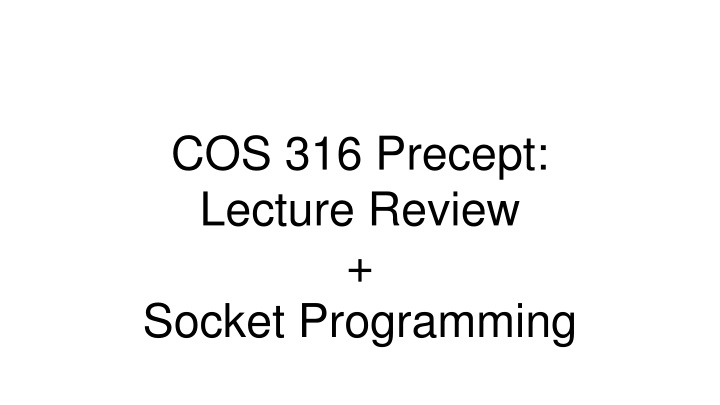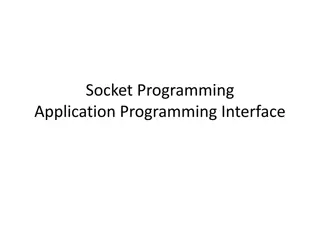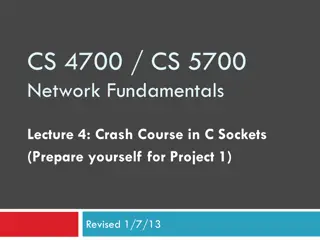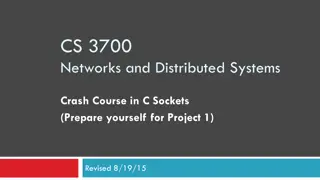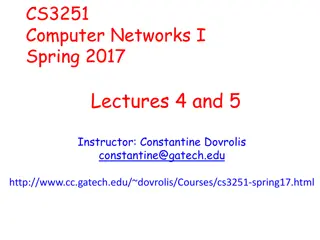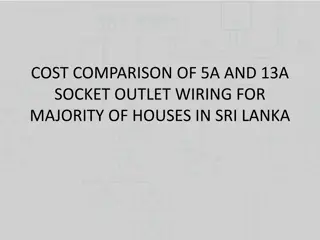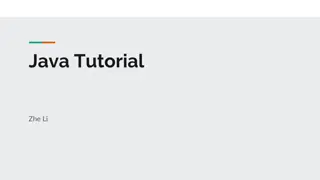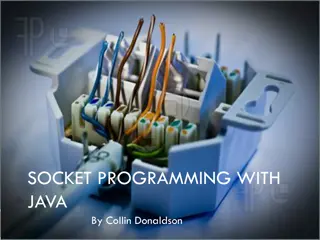COS 316 Precept: Lecture Review & Socket Programming
In this detailed presentation, topics include memory addressing, terminology, abstractions, physical and virtual memory, and more. The content sheds light on the complexities of computer systems and the need for various levels of abstraction for simplification and enhanced capabilities.
Download Presentation

Please find below an Image/Link to download the presentation.
The content on the website is provided AS IS for your information and personal use only. It may not be sold, licensed, or shared on other websites without obtaining consent from the author.If you encounter any issues during the download, it is possible that the publisher has removed the file from their server.
You are allowed to download the files provided on this website for personal or commercial use, subject to the condition that they are used lawfully. All files are the property of their respective owners.
The content on the website is provided AS IS for your information and personal use only. It may not be sold, licensed, or shared on other websites without obtaining consent from the author.
E N D
Presentation Transcript
COS 316 Precept: Lecture Review + Socket Programming
Outline Memory Addressing Socket programming
Terminology A page Traditionally 4KB Unit of memory that s managed by the operating system
Memory Addressing Geometric I want the page stored in row 14, column 5 Physical I want page 5 Virtual I want (virtual) page 5
Why do we need abstractions? They make things simpler! Applications are simpler to write They allow for more capabilities (more on this later)
Physical Addressing Application A Write to page 0
Physical Addressing Application A Application B Write to page 0 Read from page 0
Application A Application B Write to page 0 Read from page 0
Virtual Memory 1. What is used to record the translation from virtual address to physical address? a. Page table. 2. How many processes share one page table? a. Only one! 3. Would the use of virtual memory hurt the r/w performance? a. Yes! 4. Any way to mitigate performance degradation? a. TLB! b. TLB: small, fast, hardware implemented cache. c. TLB misses goes to page table
What type of memory naming to use? 1. On your laptop a. Virtual naming 1. For a tiny power constrained microcontroller b. Physical naming 1. For a supercomputer that runs one massive simulation at a time b. Physical naming 1. On your phone b. Virtual naming
Abstractions How can two different computers exchange data? Complex process, involves many different components, links, etc. Computers may have different hardware, operating systems, Abstractions avoid us having to worry about this A way of reducing implementation complexity into simpler concepts Focus on their abstraction paradigm Many examples for abstractions in modern systems Files, Terminals (TTYs), Today: sockets!
What are sockets? And connections? Connection Many different definitions! In this context: an established method to communicate between a process on one host (A) and a process on another host (B) A communication channel An abstraction; in this case spanning multiple (physical) systems Socket An endpoint of a given connection Connections are established between two sockets Just another abstraction! The system-local abstraction of a connection
Client Server Communication A paradigm describing how a connection is initiated between two sockets Client Server Actively initiates the connection Passively listens for and accepts connections Typically sometimes on (e.g., web browser on your phone / laptop) Typically always on (e.g., web server for google.com in some data center) Needs to dial the server thus requires its address! Must be reachable under some address Recall: a connection is established between two processes on some hosts Thus, an address is composed of a host identifier (IP address) and a process identifier (port number)
Stream Sockets (TCP): Connection-oriented Server socket( ) Create a socket Listening socket Bind the socket (assign to a given host and port identifier) Client bind() Bound to just the local host & port address Create a socket socket() Listen for client (Wait for incoming connections) listen() connect() Connect to server accept() Accept connection write() Send data read() Receive Data Connected socket write() Bound to both local and remote host & port address Send data Receive data read() 16
Datagram Sockets (UDP): Connectionless Server Client Create a socket socket( ) Create a socket socket() Bind the socket bind() Bind the socket bind() sendto() Send data recvfrom() Receive data sendto() Send data recvfrom() Receive data 17
Assignment 1 Write a pair of programs implementing the server client connection- oriented socket paradigm Using stream sockets (TCP) Two files you ll modify: client.go and server.go Having a client send data to a server And let the server print this data This precept does not address all requirements of the assignment! Purpose is to give you an idea of how to get started.
Client Milestone 1: Connect to a Server We ll need to retrieve the server address from the command line and connect to it go s net.Dial function looks promising! Read its documentation to figure out the expected server address format Read the server address from the command line arguments You can find those in os.Args in go! The first argument (os.Args[0]) is always the executable name Client go s net.Dial() Create a socket socket() connect() Connect to server returns a Conn object
Client Milestone 2: Write Data & Close Connection The client will need to read a message from standard input Place the message in a buffer Write the contents of that buffer to the socket conn Use conn.Write to write some bytes to an established connection (established socket) Use conn.Close to close a connection This informs the opposite end socket that the connection is no longer established Both sides can close a connection! Write() Send data Close connection Close()
Server Milestone 1: Create a Listening Socket Server To accept connections, our server must create a listening socket The net.Listen function does that! Returns a Listener, which owns a socket socket( ) Create a socket go s net.Listen() net.Listen takes a listen address Host- and process-address of server (IP & port) A server can have multiple host addresses! Listening on localhost or 127.0.0.1 only allows local connections. Bind the socket (assign to a given host and port identifier) bind() Listen for client (Wait for incoming connections) listen() Use fmt.Sprintf to combine the host- address and port number Returns a net.Listener
Server Milestone 2: Accept a Connection & Read Data net.Listener A Listener can accept an incoming client connection with the Accept method returns a net.Conn, same as on Client! Accept() blocks until a client connects! Accept a connection net.Conn can receive data through the Read() method Takes a buffer as argument go s net.Conn (owns a connected socket underneath) Accept a client connection Read() Receive Data
Server Milestone 3: Handling a Client Close() Both sides can close a connection What if that happens during a Conn.Read()? go s net.Conn (owns a connected socket underneath) Conn.Read() returns an EOF error! End of file Check for this error. If it occurs, close the connection. err may be set to nil check for this first! err provides the Error() method, which returns error codes as strings Read() Receive Data EOF
Tips and Common gotcha fmt.Sprintf could be handy Don t print the entire buffer Convert bytes to string when printing Client needs to close() at end of connection EOF is not a character, it s a type of error
